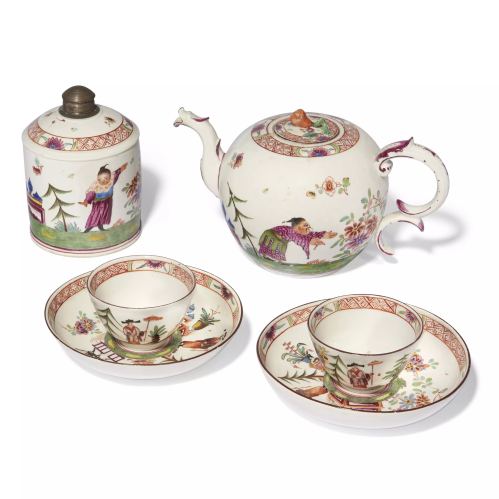The Höchster Porzellan-Manufaktur (Höchst Porcelain) was founded in 1746 by business partners merchant Johann Christoph Göltz, his son-in-law Felician Clarus, and the ceramic painter Adam Friedrich von Löwenfinck (1714 - 1754). The go-ahead for the establishment of the manufactory was given by the Elector of Mainz - one of the Holy Roman Empire’s seven Prince-Bishops - Johann Carl von Ostein, after the trio submitted a request to the court for the privilege to make porcelain. Von Ostein believed that a porcelain factory would elevate the area by supporting the economy, creating jobs, and reducing the need for imports. The right to manufacture porcelain was given for the length of 50 years, and the new factory was granted a brief exemption from certain taxes to encourage their establishment. Höchst am Main (annexed in 1928 by Frankfurt am Main) was first recognised as a town in 1355, and its famous porcelain manufacturer has the six-spoke Mainz wheel as its studio mark.
Von Löwenflick had previously been employed at the Meissen Porcelain Manufactory (around 350 kilometres from Höchst and owned by the King of Saxony) but fled to escape tight surveillance measures designed to prevent industry secrets from being leaked. In fact, von Ostein insisted that as part of his deal with Löwenflck, Göltz, and Clarus, the artist had to be willing to write down his expertise to be shared with the area administration. Another member of the Höchst Porcelain group - the chemist Johann Jacob Ringler - came to Höchst four years later in 1750 (also having left the Meissen manufactory) which kickstarted the production of porcelain at the factory (which had been making faience up to that point due to not quite achieving the right paste recipe).
Höchst Porcelain is the second oldest porcelain manufacturer in Germany, and the fourth factory in Europe to create ‘true’ porcelain. The company was officially dissolved in 1796 after having closed three years earlier due to the occupation of Mainz by the French. The manufactory was re-founded during the 20th Century (working out of a factory in Frankfurt-Sossenheim) and continues to this day (following a brief two-year hiatus between 1963 and 1965) operating under the name Höchster Porzellan-Manufaktur 1746. The company creates new designs as well as reproductions of their historical 18th-century forms.
Despite having a frequently changing group of employees and artists (which was commonplace for the industry) and going bankrupt in 1756 before a change in management under Johann Heinrich Maas, the Höchst factory managed to foster an excellent reputation and a consistent artistic quality.
The Höchster Porzellan-Manufaktur is known for its production of painted miniature figurines, vases, plates, and vessels featuring small floral details painted with enamels on white hard-paste porcelain. Particularly fine examples of Höchst pottery feature not only the Mainz wheel mark but an additional crown detail above it. Several Höchst original moulds were sold to other manufactories during its economically-unstable history, so collectors of Höchst pieces may need to train their eyes to differentiate originals from copies made by other groups.
